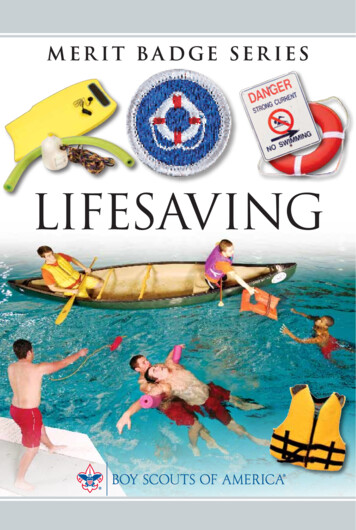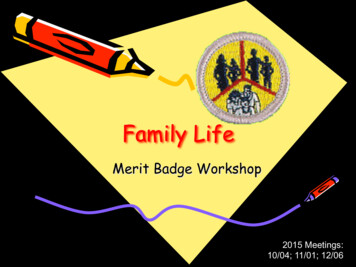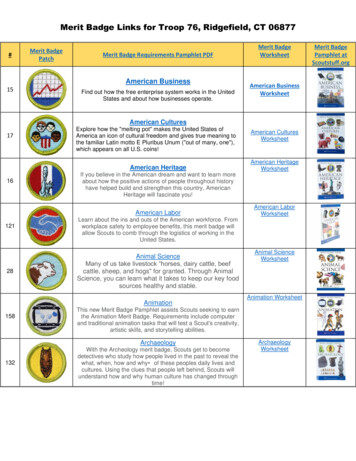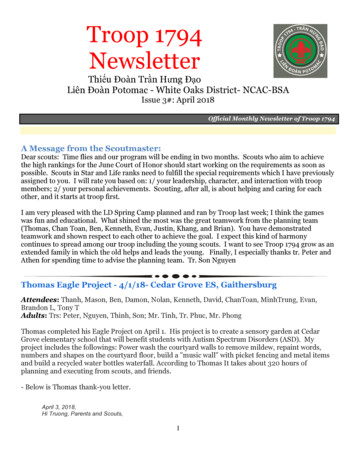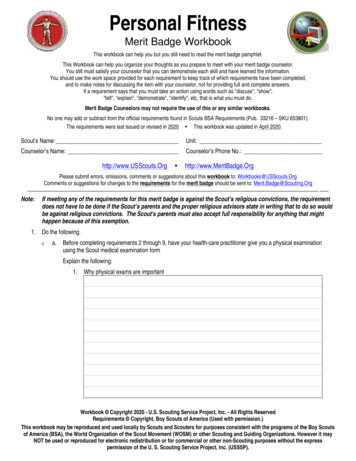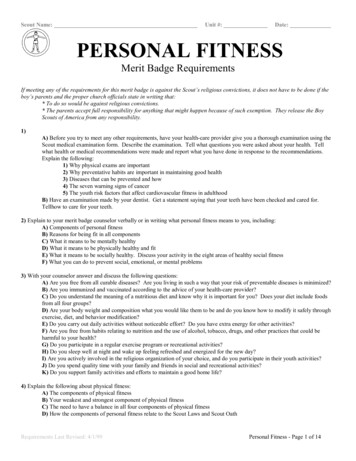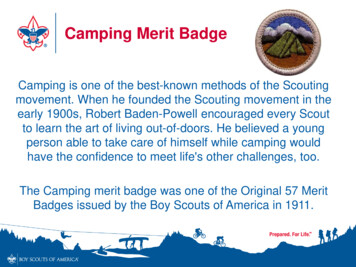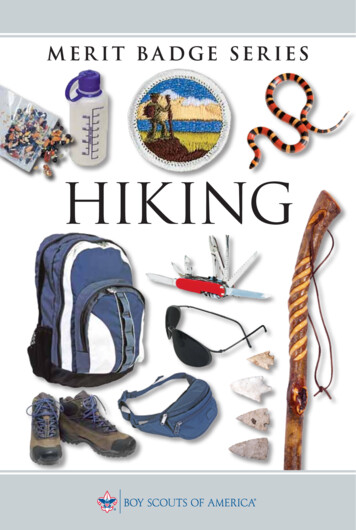
Transcription
hiking
How to Use This PamphletThe secret to successfully earning a merit badge is for you to use boththe pamphlet and the suggestions of your counselor.Your counselor can be as important to you as a coach is to an athlete.Use all of the resources your counselor can make available to you.This may be the best chance you will have to learn about this particularsubject. Make it count.If you or your counselor feels that any information in this pamphlet isincorrect, please let us know. Please state your source of information.Merit badge pamphlets are reprinted annually and requirementsupdated regularly. Your suggestions for improvement are welcome.Send comments along with a brief statement about yourself to YouthDevelopment, S209 Boy Scouts of America 1325 West Walnut HillLane P.O. Box 152079 Irving, TX 75015-2079.Who Pays for This Pamphlet?This merit badge pamphlet is one in a series of more than 100 coveringall kinds of hobby and career subjects. It is made available for youto buy as a service of the national and local councils, Boy Scouts ofAmerica. The costs of the development, writing, and editing of themerit badge pamphlets are paid for by the Boy Scouts of America inorder to bring you the best book at a reasonable price.
BOY SCOUTS OF AMERICAMERIT BADGE SERIESHiking
Requirements1. Show that you know first aid for injuries or illnesses that couldoccur while hiking, including hypothermia, heatstroke, heatexhaustion, frostbite, dehydration, sunburn, sprained ankle,insect stings, tick bites, snakebite, blisters, hyperventilation,and altitude sickness.2. Explain and, where possible, show the points of good hikingpractices including the principles of Leave No Trace, hikingsafety in the daytime and at night, courtesy to others, choiceof footwear, and proper care of feet and footwear.3. Explain how hiking is an aerobic activity. Develop a plan forconditioning yourself for 10-mile hikes, and describe how youwill increase your fitness for longer hikes.4. Make a written plan for a 10-mile hike. Include map routes, aclothing and equipment list, and a list of items for a trail lunch.5. Take five hikes, each on a different day, and each of10 continuous miles. Prepare a hike plan for each hike.*6. Take a hike of 20 continuous miles in one day following ahike plan you have prepared.*7. After each of the hikes (or during each hike if on onecontinuous “trek”) in requirements 5 and 6, write a shortreport of your experience. Give dates and descriptions ofroutes covered, the weather, and any interesting things yousaw. Share this report with your merit badge counselor.*The hikes in requirements 5 and 6 can be used in fulfilling Second Class (2a) andFirst Class (3) rank requirements, but only if Hiking merit badge requirements 1, 2,3, and 4 have been completed to the satisfaction of your counselor. The hikes ofrequirements 5 and 6 cannot be used to fulfill requirements of other merit badges.35907ISBN 978-0-8395-3407-8 2007 Boy Scouts of America2010 PrintingBANG/Brainerd, MN4-2010/059530
ContentsHiking Now and Then. . . . . . . . . . . . . . . . . . . . . . . . . . . . . . 5Get Ready! . . . . . . . . . . . . . . . . . . . . . . . . . . . . . . . . . . . . . . 11Get Set!. . . . . . . . . . . . . . . . . . . . . . . . . . . . . . . . . . . . . . . . . 31Go!. . . . . . . . . . . . . . . . . . . . . . . . . . . . . . . . . . . . . . . . . . . . 39Minimizing Risk . . . . . . . . . . . . . . . . . . . . . . . . . . . . . . . . . . 45Hiking Resources. . . . . . . . . . . . . . . . . . . . . . . . . . . . . . . . . . 61Hiking3
.Hiking Now and ThenHiking Now and ThenHave you ever wanted to roam all day through forests andfields, climb a high hill, and look far across the land? Maybeyou want to explore busy city streets, dusty farm roads,and beaches. Perhaps you are eager to see what’s aroundthe next corner and beyond the distant horizon. If so, thenhiking is for you.Hiking with othersbuilds friendships.Sharing goodtimes togetherand watchingout for oneanother deepensyour bonds withother people.Hiking gives you the freedom to travel under your own power tothe places you most want to go.Hiking is also a terrific way to keep your body and mind intop shape, both now and for a lifetime. Walking packs powerinto your legs and makes your heart and lungs healthy andstrong. Exploring the out doors challenges you with discoveriesand new ideas. Your senses will improve as you use your eyesand ears to gather information along the way.Hiking5
Hiking Now and Then.Lastly, hiking brings you closer to the earth. As the milesroll beneath your feet, you will sense the lay of the land—hillstumbling into valleys, prairies flowing toward the mountains,rivers bending the shapes of cities and towns. Earning theHiking merit badge will prepare you for exciting journeys.Hikes of 10 and 20 miles will give you the experience andconfidence to enjoy hiking as a lifetime hobby.Your pace allows you to see the plants and animals, like theseladybird beetles, that are important parts of every environment.A Short History of HikingHiking has always been a part of the human experience.When the first settlers arrived in North America, they wereon foot, probably walking across the Bering land mass or onfloes of ice from Asia to what is now Alaska. Their descendantsmade their way to every corner of the continent, one footstepat a time. They knew that going on foot would be the only waythat many of them could get from place to place. They wentfar and wide, sometimes crossing large portions of what wouldbecome the United States.By the 1800s, railroads,ships, and stagecoach linesbegan to offer Americansways to travel with littlephysical effort. Even thoughhiking was no longer anecessity, many peoplechose to keep walkinganyway. Some wantedthe exercise and fresh air.Others enjoyed the leisurelypace or the scenery. Manyfound hiking relaxing.Hiking the Pacific Northwest, 19066Hiking
.Hiking Now and ThenHiking on Mount Rainier, Washington, 1906Climbing the Sunset Trail near Asheville, North Carolina, 1912Hiking7
Hiking Now and Then.Hiking for fun took off in a big way in the late 1800s andearly 1900s. Hiking clubs encouraged people to get out andwalk. Long-distance hikers made their way from the AtlanticOcean to the Pacific Ocean. Construction of the AppalachianTrail, the Pacific Crest Trail, Continental Divide Trail, and hundreds of other routes provided the public with pathways towalk on for a day, for a week, or even for months at a time.Lord Robert Baden-Powell, thefounder of world Scouting,was a great supporter ofexploring the outdoors on ahike, as evidenced by some ofhis sketches.8Hiking
.Hiking Now and ThenOver the years the requirements for the Hiking merit badge have changed less thanthose for any other Scouting award.While hiking clothing and gear have changed with thetimes, what has not changed is the joy of hiking. It is still assimple as lacing up your shoes and taking off under your ownpower. Since the Boy Scouts of America began in 1910, Scoutshave known the freedom and rewards of setting out along atrail, down a quiet country road, or across a bustling urbanlandscape. Now it is your turn to do that, too.Hiking9
.Get Ready!Get Ready!The adventure of hiking awaits you. All you have to do is takethe first step.Kinds of HikingWhere do you want to go? What do you want to see? Hikingopportunities are all around you—in cities, on backroads,across deserts and tundra, on trails, and where there are nopath ways at all. Each kind of hiking has its own chal lengesand delights.Hiking11
Get Ready!.Urban HikingOf all Scouting adventures, city hikes can be among the mostinteresting and easiest to plan. Set a course that will takeyou through parts of town you would like to see, or to azoo, an exhibit, a museum, or a historical site. There maybe a fair, a cultural celebration, or another civic activityyou can attend. Many metropolitan areas have parks,arboretums, and greenbelts that are made for wanderingon foot. You might also be able to plan a route that takesadvantage of public transportation.Always hikewith at leastone buddy.The principles of Leave No Trace apply in the city justas they do in other areas. Leave a good impressionwher ever you go. Greetpeople along the way.If you are hiking with adog, keep your pet ona leash and pick up andproperly dispose ofpet waste. Obey trafficsignals. Lend a handwhenever you can.Prepare for urban hiking as carefully asyou would for a back country journey. Reviewyour trip plan with your Scout leaders andparents or guardian. Pack rain gear andextra clothing if there is a chance theweather will change, and take alongfood and water. Carry a cell phoneor enough coins to make severaltelephone calls, too, and moneyfor a bus, sub way, or taxi ifyou dis cover you must gethome quickly.
.Get Ready!Backroads HikingAmerica’s quiet backroadscan offer miles of wonderfulhiking. They may leadthrough farm fields, hugriverbanks, drift along in ashady forest, or head outinto open prairie.Whenever you hikeon a road, a few simpleprecautions will help keepyou safe. Walk single file on theleft shoulder so that youcan see oncoming traffic. Wear light-colored andA backroads hike will present unique opportunities toreflective clothing to help observe wildlife, such as this moose.drivers notice you. Evenbetter are bright orangevests such as those worn by highway workers and hunters. Be ready, if necessary, to step onto the shoulder of the roadto give vehicles plenty of room. When you want to cross a road, line up alongside oneanother and have everyone cross at the same time.Never hitchhike. Itcan be dangerous,it is most likelyillegal, and itspoils the spiritof a hike.When hiking on a road, always walk single file on the leftshoulder—facing oncoming traffic.Hiking13
Get Ready!.Snow HikingA winter hike can be a terrific way to enjoy cold-weatheradventures. Anticipate the conditions you are likely to encounter,select routes with obvious landmarks, and plan well. Rememberthat territory familiar in the summer can look very differentwhen it is blanketed with snow. A map and compass or GPSreceiver may come in handy for helping you stay on course.See the Boy ScoutHandbook andFieldbook forinformation aboutlayering clothingfor comfort.Sunglasses are important for snow hikers, especially onclear or hazy days, to protect your eyes from the glare. Leatherboots that have been treated to repel water can keep your feetdry and warm, and gaiters will prevent snowfrom getting into your boots. You mighteven need snowshoes to travelthrough the deep snow. Chooseclothing that is appro priate forthe season. Take along highenergy food to power youthrough the day, and drinkplenty of fluids to preventdehydration. Oh, and don’tforget the sunscreen.14Hiking
.Get Ready!Snow that is frozen after a cold night can be easy tohike across in the morning. By afternoon, though, thesun’s warmth may soften the snow enough that yourlegs plunge through with each step. Postholing thatway can be exhausting, so allow plenty of time toreach your destination.To travel across snow that is too deep and soft to supportyour weight, you may need snowshoes or cross-country skis.If you are on foot, try to avoid established trails used by crosscountry skiers and snowshoers. Deep footprints punched intothe snow can make it more difficult for those on snowshoesor skis to fully enjoy their sport.Hiking15
Get Ready!.Tundra HikingHike high enough in mountainous regions and you will reachan elevation where conditions are too harsh for forests to survive. The territory above this tree line is called alpine tundra.A tundra hike can take you up among the summits andsurround you with tremendous scenery.In tundra territory,vegetation isbuffeted byBe alert for changes in the weather, too. Afternoonthunderstorms are common at high elevations.Turn back if the weather begins to worsen, pacingyour hike so that you will be down in the treesbefore lightning threatens.the wind, andmois ture can bein short supply.16HikingAlpine tundra is a magnificent and fragile landscape thatrequires your utmost efforts to cause it no harm. Growingseasons are usually quite short, and plants are easily damagedif people walk on them. The weight of a hiker may compressthe soil, leaving it difficult for roots to penetrate. Protect tundraby staying on trails whenever possible.
.Get Ready!Tundra tips: Careless footsteps can disturb the burrowsof animals and the ground nests of birds. Watch forcairns—piles of stone used to mark routes. Duringcross-country travel, try to stay on snow or bare rocks.CairnsGlobal Positioning SystemModern technology has provided hikers witha powerful electronic means of navigation—the global positioning system. A GPS receiveraccurately calculates the longitude and latitudeof any spot on the globe by taking bearings onsatellites orbiting 12,000 miles above Earth.If you decide to use one, study the manufacturer’sinstructions and practice using the GPS before you gohiking. Once you learn to operate a GPS receiver, youcan use it to identify precise locations, determineelevations above sea level, and plot the path of a trek.Inputting this information will create a history in thereceiver that can be used if you need to retraceyour steps.Electronic navigational instruments will surelycontinue to improve in accuracy, versatility, and easeof use. But a GPS receiver (especially one with deadbatteries) is no substitute for being able to navigate thebackcountry with traditional tools. Develop confidencein your ability to use maps and compasses and then,if you wish, add to them with a GPS receiver.Hiking17
Get Ready!.Desert HikingHiking across arid country will bring you close to remarkablevegetation, wildlife, and land formations. Carry lots of drinkingwater—at least two quarts per per son, and more if the daymight be hot. A broad-brimmed hat for warm-weather use willshade your head, and light-colored cloth ing can help you staycool. Consider doing desert hiking in the early morning andevening; spend the hottest part of the day relaxing in the shade.18Hiking
.Get Ready!The blackish crust ofcryptobiotic soil ishome to many livingmicroorganisms andis especially delicate.This living soil, whichcan take hundreds ofyears to develop, canbe destroyed by asingle footprint.Storms can quickly fill dry stream bedswith raging torrents, so seek higherground during desert down pours.Desert vegetation can be as fragile asit is interesting. Stay on trails so that you donot trample small plants or compact the soilaround them. Be on the lookout for lizards, snakes, and otherdesert creatures. Step lightly, observe from a safe distance, andenjoy your encounters with them.Flash flooding is a potential danger for hikers in aridcountry. If your route becomes blocked by rushing water,wait until the stream returns to safe levels beforeattempting to cross.Hiking19
Get Ready!.Cross-Country HikingCross-country hiking invites you to escape every thing madeby humans, trails included. You might cross a river or alakeshore beach, or the crest of a hill. Or your way mightbe determined by a series of compass readings and a map tokeep your bearings.Staying with your group is as important while hiking crosscountry as it is for any other outdoor adventure. You can sharein all the fun, and be there if anyone needs your help.Smart hikers arealways willing toturn around if aroute becomesdangerous.Plot your route carefully before you begin a cross -country hike,and you should not be surprised by rivers, cliffs, or other barriers.If you run into terrain that you are not sure you can safely cross,stop and figure out a better way or go back the way you came.20Hiking
.Get Ready!Night HikingHiking during daylight hours is usually the best way to go. Youcan see where you are headed, and others, especially motorists,can easily see you. There may be times, however, when you aredelayed and need to complete a journey in the dark. Use extracare to stay on your route, and keep the members of yourgroup together.If you are caught out after dark and cannot safelycontinue—perhaps the trail is difficult to follow, orgroup members have become tired, hungry, andchilled—it may be best to stop for the night. Useyour Outdoor Essentials, good sense, and any otherresources to keep your group safe and comfortableuntil you can move on in the morning light. See theWilderness Survival merit badge pamphlet for moreinformation on making do with what you have.Hiking21
Get Ready!.Trail HikingScouts do much of their hiking on trails. They may choosepathways leading deep into the backcoun try, or shorterroutes connecting points of interest in a Scout camp or acity. A trail can lead to a mountaintop, a lake, a neighborhoodpark, or a prairie.Trails are opportunities. Ifeveryone stays on that pathway,vegetation on either side will not betrampled and erosion is less likelyto occur. (By contrast, hikers goingcross-country may spread out toavoid creating unwanted trails.)Trails often have structures tohelp travelers stay safe. Retainingwalls made of rocks or logsstrengthen the sides of trails.Water bars set across the treaddivert water from the pathwaybefore it can cause erosion. Bridgesconstructed of lumber or logscarry trails over streams and gorges.Staircases of wood or stone canease steep ascents. Culverts channelwater from rain, springs, andmelting snow under the tread.Trail Corridors and Switchbacks. Every pathway passesthrough a trail corridor—the space cleared of branches andvegetation above and to each side of the tread. The corridorgives trail users room to pass with ease. A trail shared withhorse back riders will have a higher and wider corridor thanwill a simple foot pathway.Because water from rainstorms and melting snow can rushdown a pathway and transform it into a gully, trails climbing asteep hill or a mountain may zigzag at a gentle grade that iseasy on the land and on you. These turns are called switchbacks. Stay on the pathway and always go completely around aswitchback; don’t take a shortcut from the upper leg of the trailto a lower leg. Cutting across switchbacks can crush vegetationand loosen soil. Before long, water from rainstorms or meltingsnow can gouge out a trench that ruins the switchback, exposingthe hillside to further erosion.22Hiking
.Get Ready!Canada geeseAs you hike a trail, try to figure out why it was built whereit is. Perhaps it swings around the edge of a meadow ratherthan leaving a scar through the middle of a clearing. It mightstay back from a lakeshore to help protect fragile vegeta tionand nesting grounds. Take a good look at trail structures, foot bridges, retaining walls, drainage devices, etc. Try to determinehow they were con structed and the roles they play.Many Scout units adopt pathways and take responsi bilityfor seeing that trails are kept in good shape. Trail maintenanceservice projects include cutting back brush, repairing tread,cleaning out drainage structures, and restor ing areas damagedby erosion.Hiking23
Get Ready!.Trip PlansFor more on theOutdoor Essentials,see the “GetSet!” chapter.A trip plan prepares you for the challenges of a hike, acampout, or any other outdoor activity. Write down thefive W’s of a trip plan: Where are you going? Decide on a route to your destination and back. For backcountry trips, include a copy of amap with your route marked in pencil. When will you return? If you are not back reasonablyclose to the time on your trip plan, Scout leaders andfamily members can take steps to locate you and, ifnecessary, provide assistance. Who is hiking with you? List the names of your partners.If you need a ride to or from a trail, write down who willdo the driving. Why are you going? To fish in a lake? Climb a peak?Explore a new area? Write a sentence or two about thepurpose of your journey. What are you taking? Always carry the Outdoor Essentials.If you are camping out, you may need additional food, gear,and shelter.24Hiking
.Get Ready!Be sure to leave copies of your trip plan with atleast two responsible adults.Hiking25
Get Ready!.Leave No Trace HikingCaring for the environment is an important responsibility ofevery hiker. The principles of Leave No Trace can help you liveup to that responsibility and enjoy the outdoors fully by knowing that you are respecting the environment.Leave No Trace PrinciplesAs you and your group plan a hike, ask yourselves how youcan follow each of the principles of Leave No Trace.Plan Ahead and Prepare. When planning your hike, contactthe land managers of the area you intend to visit or the LeaveNo Trace Center for Outdoor Ethics (see the resources sectionfor contact information). Explain your desired route and askhow you can best implement Leave No Trace. Here are someadditional guidelines to remember. Know the regulations and special concerns for the area youwill visit. Prepare for extreme weather, hazards, and emergencies. Schedule your trip to avoid times of high use.In pristine areas,disperse use toprevent thecreation of newtrails. Avoid placeswhere impactsare just beginning. Visit the backcountry in small groups no larger than partiesof four to six hikers.Travel on Durable Surfaces. Stay on existing pathways to helpprotect the surrounding landscape from being trampled, eroded,and compacted. In popular areas, hike on durable surfaces such asestablished trails, rock, gravel, dry grasses, and snow. Protect shoreline vegetation. Walk single file in the middle of the trail, even if itis wet or muddy. Conduct activities inareas where vegetation is absent.26Hiking
.Get Ready!Dispose of Waste Properly. Remember this solid guideline:Pack it in, pack it out. Make it easier on yourself by limitingthe amount of potential trash you take.Especially important is the disposal of human waste. Usetoilet facilities whenever possible. Otherwise, urinate away fromtrails, camps, and other gathering places. Choose rocks or bareground; animals may strip vegetation in order to consume thesalts left by concentrations of urine. Pack out solid waste, oruse a cathole. Check with the land agency for the area you willvisit to find out the preferred method.To dig a cathole, choose a remote spot at least 200 feetfrom camps, trails, water, and dry gullies. With a trowel, diga hole 6 to 8 inches deep in the topsoil. Take care of business,re-cover the hole, and disguise the site with leaves or otherground cover. Organic material in the topsoil will slowly breakdown the waste, making it harmless.Leave What You Find. A cluster of flowers beside an alpine trail.Bricks from a historic homestead. A bird’s nest on a low bush.Every hike will bring with it a new discovery to see and enjoy.Here are some reasons why you should leave what you find. Future hikers will have the excitement of discovering forthemselves what you have found. Plant and wildlife environments will not be harmed. Leaverocks and other natural objects as you find them. Avoidintroducing or transporting nonnative species. Archaeological, cultural, and historic structures and artifactspreserve a record of America’s past; some are sacred toAmerican Indians and other Native Americans. Observe, butdo not touch or take.Hiking27
Get Ready!.Minimize Campfire Impacts. Most hikers are prepared tospend a day outdoors without needing a campfire. If you doexpect to cook or get warm, plan ahead with options that donot depend on kindling a blaze. In any case, it is wise to knowwhen a campfire can be lit and when a fire could scar the land.In many areas, fires are discouraged, prohibited, or allowed bypermit only. If you must make a campfire: Use established fire rings, fire pans, or mound fires. Keep fires small. Use only sticks from the ground that can bebroken by hand. Burn all wood and coals to ash, make sure the ashes are coldout, then scatter the cool ashes.Respect Wildlife. Sharing the outdoors with wildlife is one ofthe great pleasures of hiking. Respect wildlife by always traveling quietly and observing animals from afar. You are too closeif your actions cause an animal to change its activities. Alwaysavoid wildlife when they are mating, nesting, raising young,and during other sensitive times.MallardAntelope groundsquirrelPrairie dogRaccoonNever feed wild animals. Doing so damages their health,alters natural behaviors, and exposes them to predatorsand other dangers. Store all your food and trash securely.28Hiking
.Get Ready!Be Considerate of Other Visitors. Extending courtesy to otheroutdoor visitors is a natural habit of hikers. Speak softly andrespect their desire for quiet and solitude. Leave radios andelectronic devices at home. If you carry a mobile telephone foremergency communication, turn it off and stow it in your packuntil you need it. Appreciate the company of those you meet onthe trail and at campsites near yours.Observe proper trail etiquette. If you encounter horsebackriders or pack animals, stop and ask the lead rider what youshould do. The lead rider will probably ask you to step a fewpaces downhill from the trail and stand quietly while theanimals pass. If you encounter other hikers or backpackersgoing uphill when you are going downhill, give them theright-of-way. Step aside on a rock or a log to minimize yourimpact, and watch your footing when you step below the trail.Control pets at alltimes, or leavethem at home.Hiking29
.Get Set!Get Set!Setting off on a hike without properly preparing can havedisastrous results. Make sure you are ready, from yourphysical condition to the best gear for the trip.ConditioningTo enjoy hiking to the fullest, you will want to be in goodshape. That is why requirement 3 calls for developing a planfor conditioning yourself. Begin with short trips, increasingthe length of your journeys as you become more fit. A goodway to prepare for Scout hikes is to walk when ever you canrather than riding in a car or relying on public transit.Aerobic ActivitiesThe word aerobic means “with oxygen.” Aerobic activitiesincrease the rate of your breathing and your heartbeat, andpush your body to use oxygen more efficiently. Aerobic trainingcan strengthen your circula tory and respiratory systems,add mass to muscles and bones, burn excess fat, and lead toimprovements in overall fitness. For aerobic activities to beeffective, you must take part in them for half an hour or moreat least three times a week, maintaining enough intensity tobreak a light sweat.Walking a coupleof miles to schoolor a friend’s homemay take a littlelonger thandriving there,but it is fun,economical, andgood for your body.Swimming might appear to be unrelated to hiking, but it will helpyou keep in shape for future hikes.Hiking31
Get Set!.Hiking is one of many aerobic activities you can use tostay healthy and fit. Other activities include bicycling, snowboarding, jogging, and swimming. Soccer, basketball, tennis,and other sports involving constant motion can have a role inaerobic training, too. The success of aerobic con ditioning liesnot so much in the mix of activi ties you choose, but rather inenjoying them regularly and pushing yourself each time toachieve a little more.Footwear and Foot CareLeather boots are a good choice if you willbe traveling on rugged trails, or in snow,or carrying a heavy pack.Almost any shoes will do for shortwalks on easy terrain. Lightweightboots with uppers made of nylon orother tough fabric are fine for mosthiking in good weather. Avoid heavyboots. Leather boots will give yourfeet and ankles added pro tection andsupport, and will keep snow and rainfrom soaking your socks. Boots madefor moun taineering or serious winteruse are probably more than you willneed for everyday hikes.Whatever shoes or boots youchoose, they must fit well. Your heelsshould not slip much when you walk,and your toes should have a littlewiggle room. Break in new bootsbefore you use them on a long hike.Wear them around at home wheneveryou can, and then on walks of increas ing length. If your feet seem slow toadapt to new boots, wear them withsocks that are thinner or thicker thanyou usually use; see if that works.Caring for Shoes and BootsClean your footwear after a hike, especially if they have become caked withmud. You can use a brush to removedried dirt, or wash the uppers withwarm water and a cloth.32Hiking
.Get Set!Your feet willcarry you morethan 100,000 milesin your lifetime. Bekind to them andthey should covermost of thosemiles withoutmuch complaint.Allow wet boots and shoes to dry at room temp erature.Too much heat can melt nylon and cause leather to harden, sodo not put your boots too close to a heat source. Treat leatherwith boot dressing containing beeswax, silicone, natural oils,or other protective ingredients that keep it flexible andwater-repel lent. Warm leather absorbs dressing well. Setyour boots or shoes in the sun for an hour, then rub thedressing into the leather with a clean cloth or your fingers.SocksSocks cushion your feet and help keep them dry. They protectfeet against blisters by reducing the friction between your skinand your footwear.When you hike in athletic shoes, cotton socks may bejust right. With boots, try wearing hiking socks madeof wool or a blend of wool and nylon. Many hikers liketo put on a thin pair of wool or synthetic-blend socksunderneath their hiking socks. The inner socks wick moisture from the skin and slide against heavier outer socks.Carry an extra pair or two of socks on your hikes.Changing into clean, dry socks during the day will refresh yourfeet. Tie damp socks on the out side of your pack to dry.Hiking33
Get Set!.Clothing for HikingFor more onlayering and onfoul-weathercloth ing, seethe Boy ScoutHandbookand Fieldbook.Dress for the outdoors by wearing layers so that you can adjustyour clothing to meet changing weather con ditions.Clothing forWarm-Weather Hikingo Scout shirto T-shirto Hiking
First Class (3) rank requirements, but only if Hiking merit badge requirements 1, 2, 3, and 4 have been completed to the satisfaction of your counselor. The hikes of requirements 5 and 6 cannot be used to fulfill requirements of other
